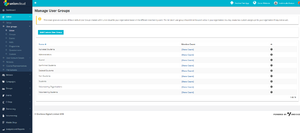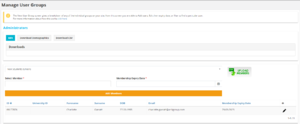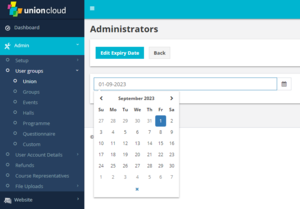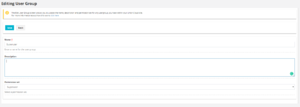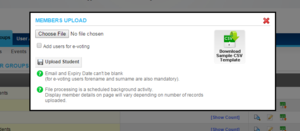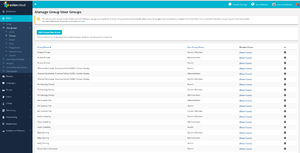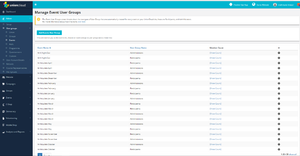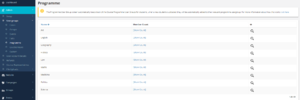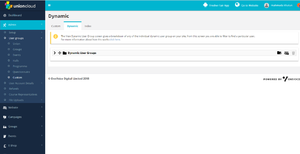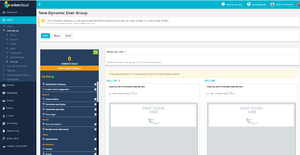User Groups & Permissions
The User Groups and permissions screen, is one of the most commonly used screens for Union Administrators. It contains all of the default permission groups created by UnionCloud on your behalf, the groups students are placed into by default. It also stores the sub sections for viewing group (Club & Society) membership groups (Administrators, Current, Alumni etc.), Events group lists, halls group lists, programme names, and their membership counts, demographic groups, and importantly Custom groups.
One of the reasons for it's heavy use is, that it is the easiest way to control which users have access to what, once you have your Permission Sets sorted and applied to a user group, as we explain further down, all you need to do is add a user to that group.
Contents
Union
You can find this page on your own site at url: <yoursite>/administrator/user_groups
The Union Sub Menu, these groups here are some of the most important, and also the groups that users will be placed into automatically upon registration / upload / expiry.
Default User Groups Breakdown
| Name | Description |
|---|---|
| Activated Students | This group is empty by default, and you can't upload users to it, Confirmed Students, move to this group, after logging in for the first time. |
| Administrators | This is the Default Union Administrator group, who have permissions to manage all website content. |
| Alumni | This group is empty by default, but once a users course date expires, they move out of Confirmed Students, and into Alumni. |
| Confirmed Students | This group is populated by data upload, and is the group of students that you are confirming you know are students, this can then be used for elections etc. |
| Deleted Students | This group is for users that have requested to be removed from the system, it excludes them from all comms, records, reports etc. They remain in this group as there is still content linked totheir accounts from previous purchases and the like, in case this ever needs reporting on. |
| Non Students | This group is populated by anybody that registers with a non-university email address and can't confirm they are a student. |
| Students | This group is populated by all users who register with the domain you set for your institution (usually x-universitycollege.ac.uk) plus anyone in the 'Confirmed Students' Usergroup. |
| Students Waiting for University Email Access |
If you have checked the box indicating registration has to be done via university email address, and a user indicates they don't have access to it pre-arrival, they will be added to this list, allowing them to register with a personal email address also, and merge their accounts once they have access. |
| Volunteering Organisations | If you have the Volunteering Module included in your package, you will have this option, when new Volunteering Organisations register, to list opportunities, then a Volunteering Administrator will need to approve them in the Volunteering Dashboard, then they will be added to this group, and be given permissions to manage Volunteering Opportunities. |
| Volunteering Students | Any student who has signed up to the Volunteering module will be added to this group, as it is confirming the group of students who have registered their interest to volunteer, and listed the areas they are interested in / skills they have. |
Other Features within Union subsection
Show Count
Previously you may remember this used to show the number of members in each screen by default, this meant that it performed a count function for a large number of groups in some cases, every time a page like this loaded, which caused larger burdens on the server, so to improve page load times this feature was removed and replaced with the line of text in blue, which on click performs a count for the group in question.
View User Group
This screen gives you an overview of an individual User Group, at the top you can see the title of the group you are in, highlighted with a blue font.
- Adding New Users
- Manually
- You can add users manually using the three boxes under the group title, the method is as follows;
- From the drop down list, choose a group you know the user is already a member of
- Search for the user by their name, it will return to you close matches, and Dates of Birth to allow you to check you have the right person
- Choose a membership expiry date for the user, this should be a year or so, and checked regularly to ensure there are no dormant accounts with permissions they shouldn't have.
- Select the 'Add members' button to finish the process.
- CSV Upload
This is the same as in the #User Group Member Upload section below, there are just two places you can select this option.
- Filter / Sort Users
The header row of the table, with the darker grey background is of much use, particularly when you are dealing with groups containing thousands, or even tens of thousands of users. You can both filter and sort any users in this table, and it also allows you to filter by multiple fields, and use part matches. You can click any of the Column headings to sort (ID, University ID, Forename, Surname, DOB, Email Membership Expiry Date), primarily it will sort (A-Z) in field which can contain strings, and (0-9) in a field that contains numeric values, however if you click the heading a second time, it will filter this to the reverse.
With regards to filtering, this works almost the same, to make the filter section appear, all you need to do is click the small cocktail glass looking symbol in the far right hand column, and it will reveal the menu as pictured to the right hand side. You can filter by any of the same fields as outlined above, with the exception of Membership Expiry Date, and the only filter that works differently is Date of Birth, this filter gives you two calendar options, Start and End, which will return all user whose DoB falls within the range.
Finally, there are two buttons below the filter button, one to reset your filters, and another to apply the filters you have just typed in the fields, alternatively you can press return on the keyboard to update.
![]() Note: Remember, you can use multiple filters AND sort in conjunction with each other, particularly useful if you are looking for someone with a common name!
Note: Remember, you can use multiple filters AND sort in conjunction with each other, particularly useful if you are looking for someone with a common name!
- Edit a Users Expiry Date
Editing a users Expiry date is a fairly straight forward function, it just requires the user to click the Edit button(![]() ), in the far right hand column, this will take you to the screen pictured in the thumbnail to the right where you can use the calendar to pick a new expiry date for the user, and then simply click the 'Edit Expiry Date' button, and you're done!
), in the far right hand column, this will take you to the screen pictured in the thumbnail to the right where you can use the calendar to pick a new expiry date for the user, and then simply click the 'Edit Expiry Date' button, and you're done!
- Feedback: Currently we have on the feedback log, a request for users to be able to instantly remove users from particular user groups, as the current method is to set their expiry to the next working day.
- Edit
The Edit button![]() at the bottom of this page takes you to the same page as the edit button before you click into a specific user group, and we will cover that below or you can click here to skip to it.
at the bottom of this page takes you to the same page as the edit button before you click into a specific user group, and we will cover that below or you can click here to skip to it.
For any particular group, a screenshot is provided on the right for your convenience.
- Download Demographics
After clicking the Download Demographics button, a timing icon will appear in the Downloads section at the bottom of the page, this usually takes a few seconds, but under peak times and heavy usage could take up to a minute or so, for the site to gather the data, and present you with a PDF to download, this is a short 2 page document containing the Demographic data for all members within the group you are currently managing. We will cover the content of the Demographics Report in another section.
- Download CSV
The final option within the View Usergroup screen is to Download a CSV of the group members, this downloads data on all of the users in the current group you are managing, in CSV Format, the data also matches the format used in the Student Upload file, so you will be getting Nationality, CourseID, StudentID, etc.
Edit User Group
The Edit page is where it gives you the options to;
- Rename
- Update Description For
- Change Permission Set
User Group Member Upload
Before we begin talking through this section, if you click on the title to this section 'User Group Member Upload' it will take you to a page where we talk through CSV Uploads in slightly more detail.
It doesn't matter which method you use to select the User Group Member Upload Option, the small CSV Upload button(![]() ) on the right-hand side of the 'User Groups & Permissions' screen, or the View User Group Option, which you get to by selecting the View button(
) on the right-hand side of the 'User Groups & Permissions' screen, or the View User Group Option, which you get to by selecting the View button(![]() ) on the right-hand side next to any of the user groups, to get the more detailed view for a particular user group, and a list of its current members, then there is a large, 'Upload Members' Button on the right hand side.
) on the right-hand side next to any of the user groups, to get the more detailed view for a particular user group, and a list of its current members, then there is a large, 'Upload Members' Button on the right hand side.
Once the pop up appears you are presented with a number of options.
- Choose File button, to upload a CSV
- A Checkbox to add users for e-voting
- An icon to the right to 'Download Sample CSV Template'
- And two notifications, which we will clarify here;
- 'Email and Expiry Date can't be blank' (For e-voting users forename and surname are also mandatory)
- Email and Date of Birth are the required fields that UnionCloud uses to find a user in the database and add them to the correct user group
- 'File processing is a scheduled background activity.
- All files you upload will be processed at midnight local time, this is because processing large quantities of database puts an increased load on the server and to do it at peak time would cause an increase in page load times and a poorer experience for all members. Please bear this in mind when you need to upload Member files.
Groups
You can find this page on your own site at url: <yoursite>/administrator/user_groups/groups
Default Group User Groups Breakdown
As mentioned in the caption, this screen is the overview screen for all of the 'Group' User Groups. That is to say, it will show all of the different User Groups, from all of your Clubs, Societies, Sports, Charity groups etc. Every new student group when they are created, via the Groups Module, have three User Groups created for them by default (although Group Administrators and Union Administrators are able to add more):
| Group Name | Description |
|---|---|
| Administrator | These users will have access to run and manage groups. |
| Current Members | All users that purchase a group membership will be automatically added to this group for the duration of time the membership is set for. |
| Alumni | When a user's group membership expires they are added to the Alumni group. |
Events
You can find this page on your own site at url: <yoursite>/administrator/user_groups/events
This area allows you to manage the usergroups for all your events. By default two usergroups are automatically created for every event which you create on your site:
| Group Name | Description |
|---|---|
| Administrators | These users will have access to run and manage events. |
| Participants | All users that have booked a ticket for an event. |
For both the Groups and Events usergroups you can perform all the same actions as you could for Union usergroups, please see the section above for more details.
Halls
You can find this page on your own site at url: <yoursite>/administrator/user_groups/hall_of_residences
In this section you can view the usergroups for all your Halls of Residence of your students, if you have access to this data. This page will automatically keep track of Halls, by picking it from your Student Upload File, any record updated with a unique Halls name will create a new usergroup. On this page you are able to show the member count and filter by name. Clicking on the magnifying glass next to a usergroup will open a new page with a list of all members (and their details) in that particular usergroup. You are also able to download a CSV file of all members from this page.
Programme
You can find this page on your own site at url: <yoursite>/administrator/programs
In this section you can view the usergroups for all your students' programmes and courses, if you have access to this data. To populate this page with programme usergroups you will need to upload your programmes by going to Admin > File Uploads > Programme Upload. Programmes will also be picked up from the information uploaded from your Student Upload File, which will automatically place students into the correct programme usergroup. On this page you are able to show the member count and filter by name. Clicking on the magnifying glass next to a usergroup will open a new page with a list of all members (and their details) in that particular usergroup. You are also able to download a CSV file of all members from this page.
Questionnaire
You can find this page on your own site at url: <yoursite>/administrator/user_groups/questions
This section will show all the usergroups which were created from any registration questions which you set-up to automatically add users to a relevant usergroup as they answered the questions, depending on their response.
To set-up these usergroups go to Admin>Setup>Questionnaire. When you create a new question in this area, make sure you tick the 'Create User Group' checkbox on the Action dropdown and enter the name of the usergroup you want creating in the Usergroup name field on your answers.
For the full page on Questionnaire Settings, click here.
Custom
You can find this page on your own site at url: <yoursite>/administrator/user_groups/custom_tree
The last usergroup option which you can access from the main UnionCloud Usergroup side menu is Custom. This section is split into three areas: Custom, Dynamic and Index. We will start with the Custom type first, as this is the area that will automatically appear first when clicking on the sidebar option, which is shown in the screenshot to the right. This page is essentially a catalogue of all the custom-made usergroups on your site (any usergroups which are not default to UnionCloud). You should have a default folder Custom User Groups which houses all your custom usergroups, clicking on the arrow will dropdown all the usergroups in the folder. On this screen you have the ability to create new folders, so that you can sub-divide and arrange your usergroups for easier access and create whole new usergroups. Just click on the relevant icon on a folder to do this.
On each usergroup you have the options to edit ![]() , view
, view ![]() and delete
and delete ![]() by clicking on the corresponding icon.
by clicking on the corresponding icon.
Dynamic
You can find this page on your own site at url: <yoursite>/administrator/user_groups/dynamic_tree
![]() Note: This would be useful for when there is a current election and you want to get people to vote. You can use this filter to create a user-group to target users who have yet not voted and sending an email prompting them to vote.
Note: This would be useful for when there is a current election and you want to get people to vote. You can use this filter to create a user-group to target users who have yet not voted and sending an email prompting them to vote.
